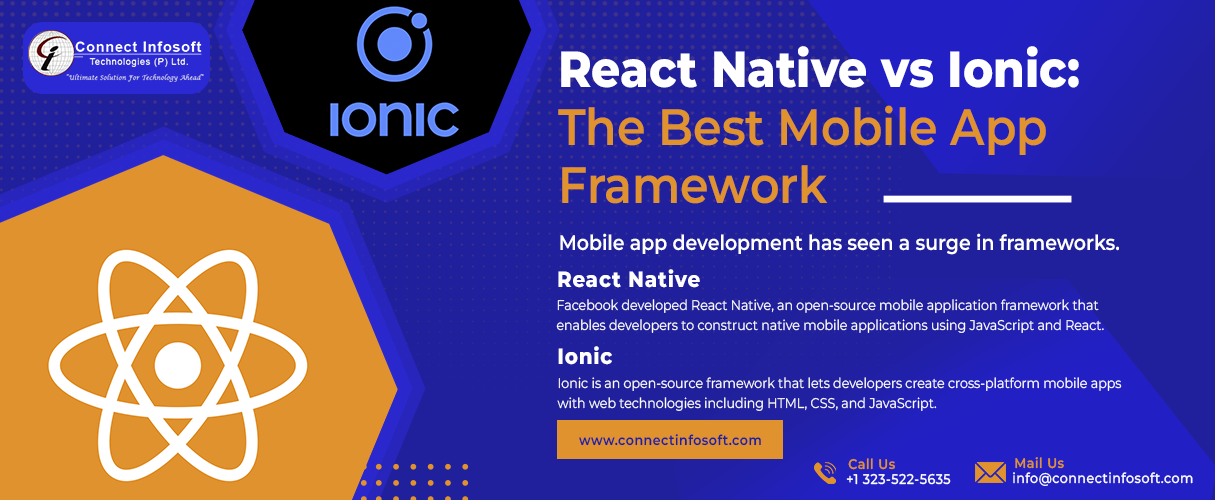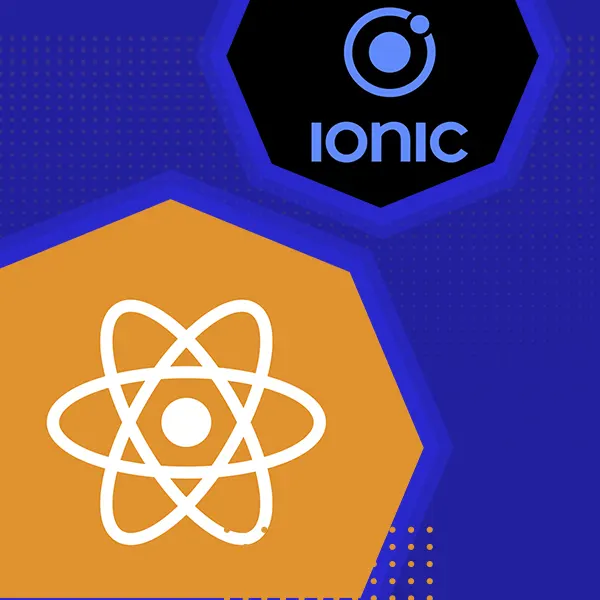React Native vs Ionic: The Best Mobile App Framework

Mobile app development has seen a surge in frameworks designed to simplify the process, improve performance, and provide a seamless user experience. Among the many frameworks available, React Native and Ionic stand out as two of the most popular choices. This article will explore the strengths and weaknesses of both frameworks, highlighting their advantages, and offering a comprehensive comparison to help you determine which is the best fit for your next mobile app project.
React Native
Facebook developed React Native, an open-source mobile application framework that enables developers to construct native mobile applications using JavaScript and React. With React Native, developers can write code once and deploy it across multiple platforms, such as iOS and Android, without compromising on performance or user experience. By leveraging a combination of React's declarative programming model and native platform capabilities, React Native enables the development of cross-platform mobile apps that look and feel like native applications. This framework has gained popularity for its efficiency, code reusability, and ability to streamline the development process for mobile applications.
Advantages of React Native
1. Performance:
React Native, created by Facebook, enables developers to create mobile apps with JavaScript and React. One of its key advantages is that it provides near-native performance. React Native compiles to native code, enabling the app to leverage device-specific hardware and operating system features, leading to faster and smoother performance.
2. Code Reusability:
With React Native, developers can write a single codebase that works across both iOS and Android platforms. This reduces development time and effort significantly, as there is no need to maintain separate codebases for different operating systems.
3. Large Community and Ecosystem:
React Native has a huge, active development community. This means extensive resources, libraries, and tools are available to help solve common problems and improve app functionality. The ecosystem also includes numerous plugins and third-party modules, enhancing the framework's capabilities.
4. Hot Reloading:
React Native's hot reloading feature allows developers to see the changes they make in real-time without needing to rebuild the app. This speeds up the development process and makes it easier to experiment with different features and designs.
5. Strong Backing:
Being backed by Facebook ensures continuous updates, improvements, and support from a tech giant with vast resources. This backing contributes to the framework's reliability and growth.
Best Practices in React Native Development
- Code Organization: Structure your code in a modular way. Break down your app into reusable components, each with a single responsibility.
- State Management: Use state management libraries like Redux or MobX to manage your app’s state effectively, especially for larger applications.
- Performance Optimization: Optimize your app's performance by using techniques like lazy loading, memoization, and avoiding unnecessary re-renders.
- Testing: Implement testing strategies including unit tests, integration tests, and end-to-end tests to ensure your app is robust and free of critical bugs.
- Navigation: Use React Navigation for handling navigation in your React Native app, as it provides a lot of flexibility and ease of use.
- Styling: Use StyleSheet for creating consistent and optimized styles. For more complex styling needs, consider using libraries like Styled Components or Emotion.
Ionic
Ionic is an open-source framework that lets developers create cross-platform mobile apps with web technologies including HTML, CSS, and JavaScript. It provides a suite of pre-designed UI components, themes, and tools to simplify the app development process. Ionic offers a seamless development experience for creating mobile applications that can run on multiple platforms, including iOS, Android, and the web, with a single codebase. This framework is known for its ease of use, extensive community support, and ability to deliver visually appealing and interactive mobile apps. Ionic is often chosen by developers looking to create hybrid apps that combine the power of web technologies with the performance of native applications.
Advantages of Ionic
1. Web Technologies:
Ionic, created by Drifty Co., leverages web technologies like HTML, CSS, and JavaScript to build mobile apps. This makes it accessible to web developers who are already familiar with these technologies, reducing the learning curve.
2. Cross-Platform Compatibility:
Ionic provides a single codebase for iOS, Android, and web applications. This unified development approach ensures consistency across platforms and reduces the time and cost associated with maintaining multiple codebases.
3. Rich UI Components:
Ionic offers a comprehensive library of pre-built UI components and themes, making it easy to create visually appealing and interactive user interfaces. These components are highly customizable and follow native design guidelines, ensuring a native-like experience.
4. Integration with Angular and Other Frameworks:
Ionic integrates seamlessly with popular frameworks like Angular, React, and Vue.js. This flexibility allows developers to choose their preferred framework while still benefiting from Ionic's features and capabilities.
5. Strong Community and Documentation:
Ionic has a robust community and extensive documentation, providing ample resources for developers to troubleshoot issues, find solutions, and improve their skills. The community also contributes plugins and extensions that enhance Ionic's functionality.
Best Practices in Ionic Development
- Code Organization: Structure your codebase effectively by organizing components, services, and modules logically. This improves maintainability and readability.
- Performance Optimization: Optimize performance by minimizing DOM manipulations, using lazy loading for modules, and reducing the use of heavy animations.
- Testing: Implement comprehensive testing strategies, including unit tests, integration tests, and end-to-end tests, to ensure the reliability and stability of your application.
- Styling: Use Ionic’s theming capabilities to create a consistent and visually appealing design. Leverage CSS variables for easy customization and theming.
- Navigation: Use Ionic’s built-in navigation controller to handle routing and navigation efficiently. Ensure smooth transitions and a consistent navigation experience.
- Use Capacitor: Prefer Capacitor over Cordova for accessing native functionalities as it provides a more modern approach and better integration with the Ionic framework.
Comparison between React Native and Ionic
1. Performance:
React Native typically offers better performance than Ionic because it compiles to native code, enabling apps to take full advantage of device-specific features. Ionic, while performant, relies on WebView to render the app, which can lead to slower performance, especially for graphics-intensive applications.
2. Development Speed:
Both frameworks offer rapid development capabilities, but Ionic's use of web technologies can give it an edge for web developers transitioning to mobile app development. React Native, with its hot reloading feature, also provides a fast development cycle.
3. User Experience:
React Native provides a more native-like user experience due to its use of native components. Ionic, though capable of delivering a good user experience, may not feel as native because it uses web technologies to render the app.
4. Community and Ecosystem:
Both frameworks have strong communities and ecosystems. React Native's community is slightly larger and more active, thanks to its backing by Facebook and widespread use. Ionic, however, has a highly engaged community, especially among web developers.
5. Learning Curve:
Ionic has a lower learning curve for web developers since it uses familiar web technologies. React Native, while still accessible, requires learning React and some native development concepts, which may take more time for newcomers.
Conclusion
Choosing between React Native and Ionic ultimately depends on your project's specific needs, your development team's expertise, and your performance requirements. React Native is a solid choice for projects requiring high performance and a native-like experience, especially if you have experience with React. Its ability to compile to native code ensures smooth performance and a seamless user experience.
On the other hand, Ionic is an excellent option for web developers looking to transition to mobile app development. Its use of familiar web technologies, a rich set of UI components, and cross-platform capabilities make it an attractive choice for many projects.
In summary, React Native and Ionic offer powerful tools for mobile app development. Assess your project's requirements, team skills, and desired user experience to make an informed decision that will set your app up for success.


